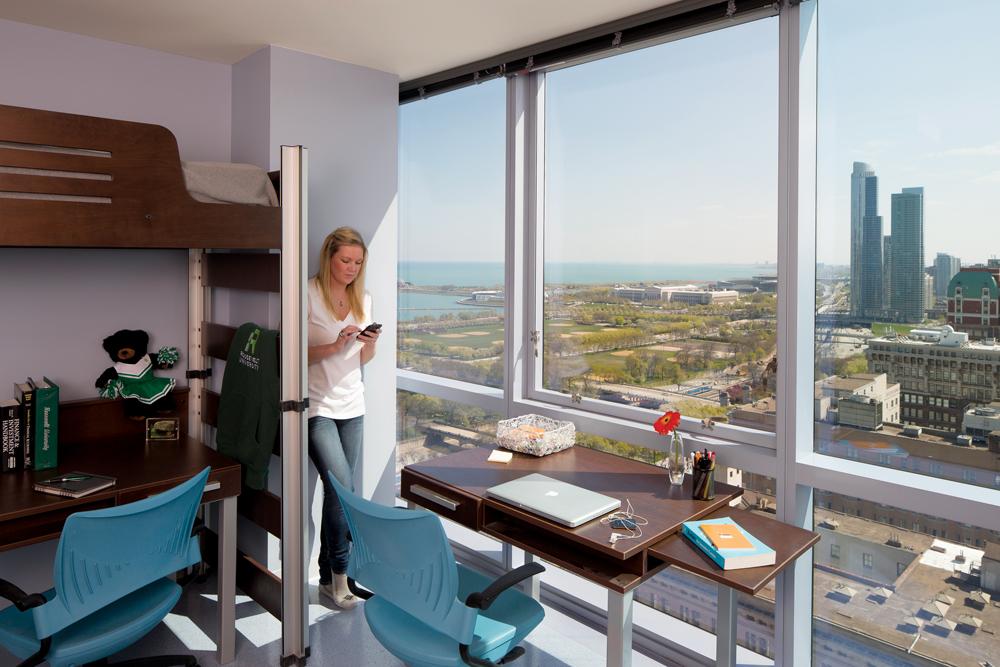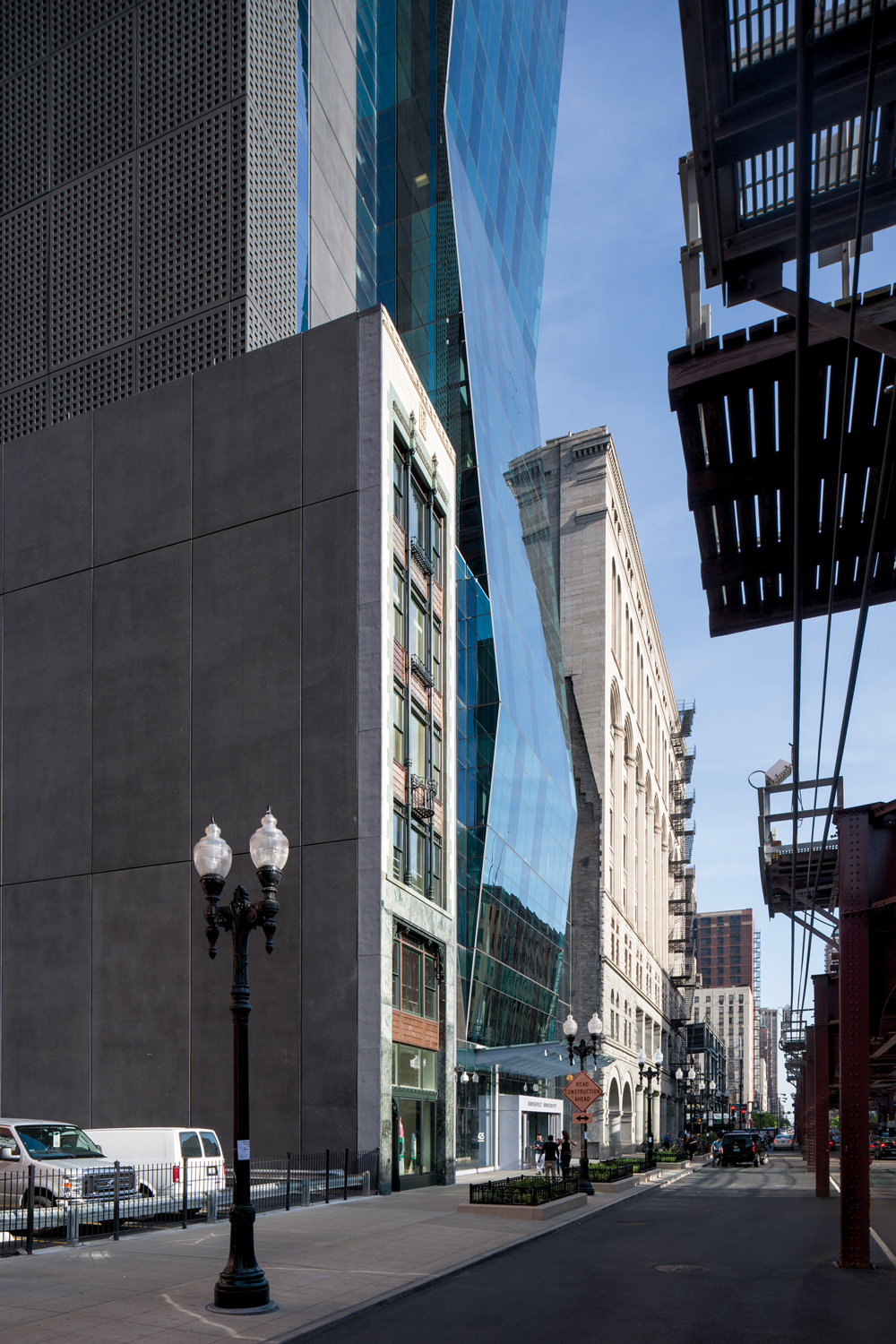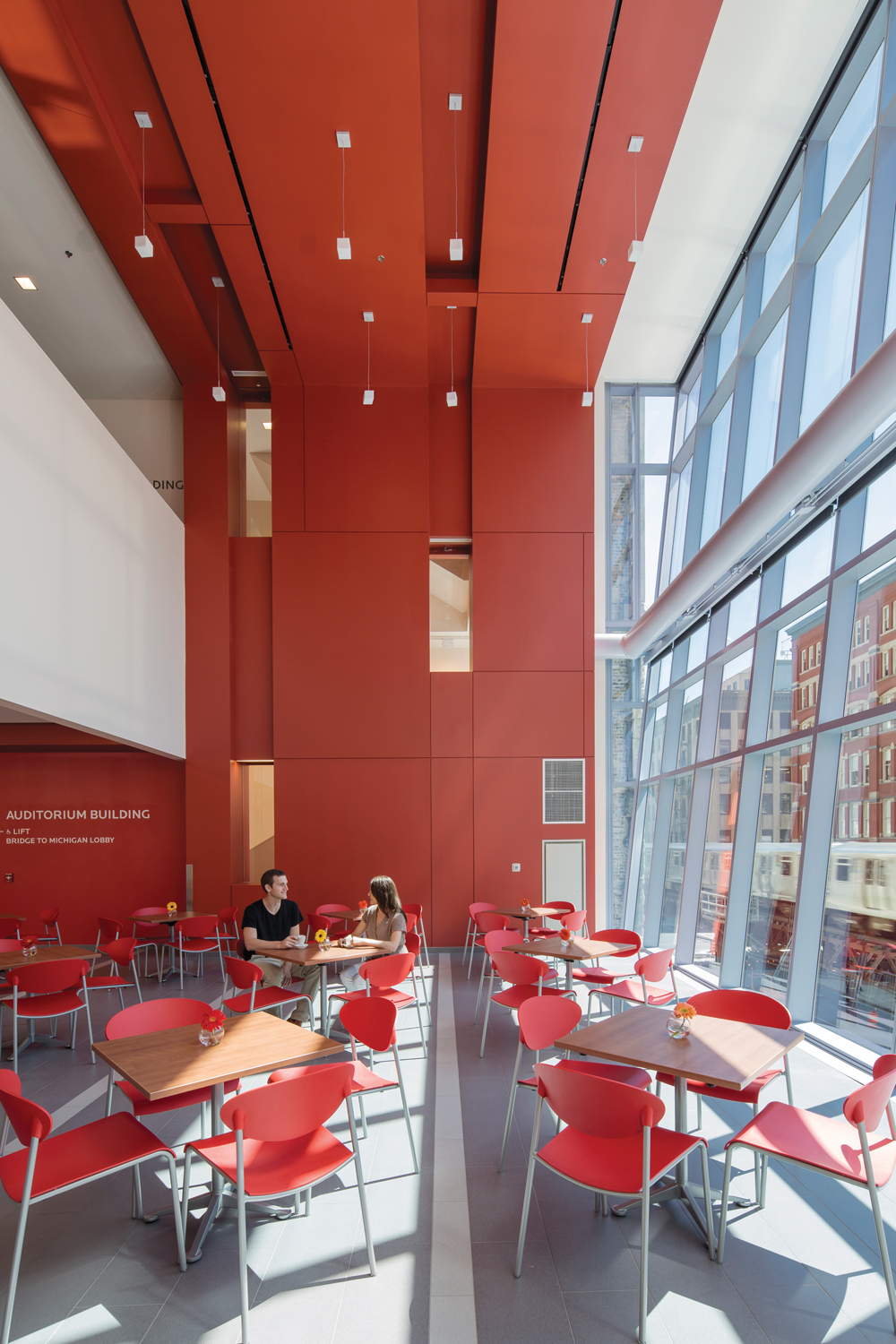Creating a tall facility on a constrained city site always presents special difficulties for Building Teams. Make the program unusually diverse—in this case, combining residential, classroom, laboratory, office, conference, dining, and recreational functions—and the complexity level increases. Now throw in the need to link the facility to a landmark 1880s structure with different floor-to-floor heights. Finally, have the city of Chicago “orange tag” one of two existing buildings on your site, derailing your plans for a complete demolition.
The Building Team for Roosevelt University’s new Wabash Building successfully navigated this minefield, producing a distinctive addition to the South Loop skyline and an appealing new home for the school. Architect VOA Associates, owner’s rep Jones Lang LaSalle, development advisor The John Buck Company, and Power Construction spearheaded a successful functional and aesthetic collaboration that also achieved LEED Gold. The resulting project, at 469 feet in height, is the second-tallest university facility in the U.S. and the sixth-tallest in the world.
From the start, the project was vastly more complex than anything the client had ever attempted. Roosevelt was already occupying the Auditorium Building, a Michigan Avenue icon designed by Adler and Sullivan, as well as a suburban extension campus. To support enrollment growth and program expansion, the university decided to create a tall building that would consolidate many functions while integrating well with the Auditorium.
Student residences include 633 beds on 17 floors, mostly in four- and five-person suites consisting of single and double bedrooms sharing a bathroom. Laundry facilities on the 15th floor feature Internet tracking so students can make sure washers and dryers are available before making the trek. Each residential floor has a large study room with breathtaking lake and city views.
With a footprint of only 17,300 sf, the tight site would need to accommodate a program of ~420,000 sf. A nondescript ’70s high-rise Roosevelt had once used for a dorm was demolished. The attractive façade of the adjacent Fine Arts Annex, a slender six-story structure built in the 1920s, was saved to become the front of a student bookstore.
The design solution created a “servant-served” spatial relationship, placing core and support (“servant”) spaces on the north elevation behind a fairly plain precast concrete façade, with unglazed lower floors giving way to a checkerboard window grid higher up. The functional (“served”) spaces are situated on the south side, featuring blue glass and dramatic canted faces inspired by Brancusi’s famed Endless Column sculpture, as well as the faceted façade of the nearby Spertus Institute of Jewish Studies. The servant-served arrangement maximizes spectacular views to the south, east, and west.
Common areas are clustered in the five lowest floors, including a two-story atrium lobby, student services offices, a student union, a dining hall, and a recreation facility. Classroom and lab spaces and a mechanical floor occupy the midsection, topped by 17 stories of residences.
The servant-served organization maximizes clear spans for the large classrooms and labs, including seven classrooms with a capacity of 36 students each, four tiered classrooms seating 60 to 80, and three auditorium classrooms seating 78 to 180. Judiciously placed prefunction spaces serve as interior “quads” for student interaction.
The façade of the slender 1920s building in the foreground was preserved as the front of a new bookstore. The dark, plain north elevation of the new tower, which faces another tall building, delineates the service functions on this side.
Three stories of science labs support instruction and research in biology, chemistry, and physics, as well as office space for science faculty. Roosevelt’s Heller College of Business was also moved to the new skyscraper from a different Loop facility; its students now benefit from a simulated financial trading room and retail store.
Vertical and horizontal circulation within the Roosevelt campus is necessarily complex. Round-the-clock security check-in is required at Floor 14 before students can proceed to the higher levels via dedicated elevators. Hooking the tower onto the Auditorium Building to the south was also tricky but crucial; the older building is still heavily used for classrooms and offices, as well as performances in beautifully restored ArtNouveau theater spaces. Gently sloping hallways now connect the buildings at four points, with generous signage provided to ease wayfinding.
Getting to LEED Gold required an imaginative mix of strategies, from the typical— high-efficiency HVAC, low-flow plumbing, green roofs—to the less common. In the latter category: removable pillow-tops to maximize mattress life cycle, façade patterning intended to deter bird collisions, a food pulper that allows dining hall waste to be hauled off and composted, and a complex network of recycling chutes with an anti-microbial washdown system.
The second-floor dining center seats 300 and offers a mini-mart for snacks and sundries, as well as cold carryout items, hot food, pizza, a deli, a grill station, and a coffee shop.
Structural and logistical issues demanded creative solutions as well, particularly with respect to crane deployment. Many projects on tight urban sites are built around a central crane, resulting in the need to finish the resulting “dead zone” after the crane is dismantled near the end of the job. Engineering-intensive lab spaces in the Wabash Building’s midsection made this scenario particularly unpalatable. Instead, the Building Team devised a method for mounting the crane outside the building footprint, using counterbalance weights and a crane elevator that hugged the façade.
Today, the Wabash Building is a lively, 24/7 community that brings the school’s social justice mission to life, hosting students from 34 states and more than a dozen countries. Chicago Tribune architecture critic Blair Kamin is among the admirers of Roosevelt’s bold experiment: “It achieves a genuine, artful dialogue between past and present … a building of considerable promise.”
This tiered classroom is one of several large, general instructional spaces provided in the building’s middle floors. Thoughtfully planned daylighting is a hallmark of the project.
Project summary
GOLD AWARD
Roosevelt University Wabash Building
Chicago
BUILDING TEAM
Submitting firms: VOA Associates (architect) and Jones Lang Lasalle (owner’s rep)
Development advisor: The John Buck Company
Associate architect: Johnson & Lee Ltd.
Structural: Magnusson Klemencic Associates
MEP: WMA Consulting Engineers
Contractor: Power Construction
GENERAL INFORMATION
Project size: 420,000 sf
Construction cost: $123 million
Construction time: November 2009 (demolition) to March 2012 (completion)
Delivery method: Design/bid/build
Related Stories
Mass Timber | Apr 25, 2024
Bjarke Ingels Group designs a mass timber cube structure for the University of Kansas
Bjarke Ingels Group (BIG) and executive architect BNIM have unveiled their design for a new mass timber cube structure called the Makers’ KUbe for the University of Kansas School of Architecture & Design. A six-story, 50,000-sf building for learning and collaboration, the light-filled KUbe will house studio and teaching space, 3D-printing and robotic labs, and a ground-level cafe, all organized around a central core.
Sports and Recreational Facilities | Apr 25, 2024
How pools can positively affect communities
Clark Nexsen senior architects Jennifer Heintz and Dorothea Schulz discuss how pools can create jobs, break down barriers, and create opportunities within communities.
Senior Living Design | Apr 24, 2024
Nation's largest Passive House senior living facility completed in Portland, Ore.
Construction of Parkview, a high-rise expansion of a Continuing Care Retirement Community (CCRC) in Portland, Ore., completed recently. The senior living facility is touted as the largest Passive House structure on the West Coast, and the largest Passive House senior living building in the country.
Hotel Facilities | Apr 24, 2024
The U.S. hotel construction market sees record highs in the first quarter of 2024
As seen in the Q1 2024 U.S. Hotel Construction Pipeline Trend Report from Lodging Econometrics (LE), at the end of the first quarter, there are 6,065 projects with 702,990 rooms in the pipeline. This new all-time high represents a 9% year-over-year (YOY) increase in projects and a 7% YOY increase in rooms compared to last year.
Architects | Apr 24, 2024
Shepley Bulfinch appoints new Board of Director: Evelyn Lee, FAIA
Shepley Bulfinch, a national architecture firm announced the appointment of new Board of Director member Evelyn Lee, FAIA as an outside director. With this new appointment, Lucia Quinn has stepped down from the firm’s Board, after serving many years as an outside board advisor and then as an outside director.
ProConnect Events | Apr 23, 2024
5 more ProConnect events scheduled for 2024, including all-new 'AEC Giants'
SGC Horizon present 7 ProConnect events in 2024.
75 Top Building Products | Apr 22, 2024
Enter today! BD+C's 75 Top Building Products for 2024
BD+C editors are now accepting submissions for the annual 75 Top Building Products awards. The winners will be featured in the November/December 2024 issue of Building Design+Construction.
Laboratories | Apr 22, 2024
Why lab designers should aim to ‘speak the language’ of scientists
Learning more about the scientific work being done in the lab gives designers of those spaces an edge, according to Adrian Walters, AIA, LEED AP BD+C, Principal and Director of SMMA's Science & Technology team.
Resiliency | Apr 22, 2024
Controversy erupts in Florida over how homes are being rebuilt after Hurricane Ian
The Federal Emergency Management Agency recently sent a letter to officials in Lee County, Florida alleging that hundreds of homes were rebuilt in violation of the agency’s rules following Hurricane Ian. The letter provoked a sharp backlash as homeowners struggle to rebuild following the devastating 2022 storm that destroyed a large swath of the county.
Mass Timber | Apr 22, 2024
British Columbia changing building code to allow mass timber structures of up to 18 stories
The Canadian Province of British Columbia is updating its building code to expand the use of mass timber in building construction. The code will allow for encapsulated mass-timber construction (EMTC) buildings as tall as 18 stories for residential and office buildings, an increase from the previous 12-story limit.





















